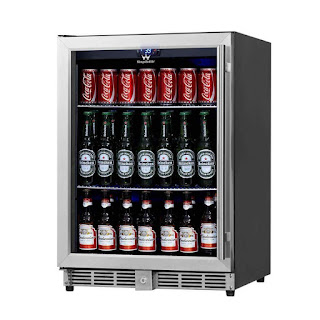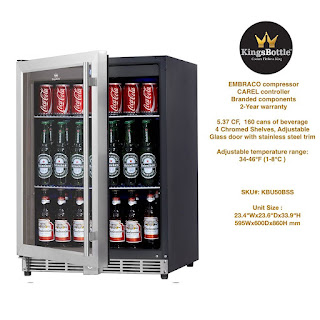What are Single Zone & Dual Zone Under Bench Beverage Coolers?
What makes a good bottle of wine? Many people say it's the quality of the soil in which the grapes are grown, the quality and type of grapes, or the quality of the old barrels, but they are all wrong. This is not to say that grapes, soil, and barrels are unimportant, but none of them are as important as temperature. The right temperature determines how quickly a wine will age and the balance of flavors. And, this is where under bench beverage coolers help you a lot.
Chilling a bottle of wine too long or leaving it out in the hot sun for several hours will result in a tainted state. This is why winemakers spend so much time in temperature-controlled cellars and why wine beverage manufacturers spend so much money on wine coolers. A wine cooler is a small refrigerator that keeps wine perfectly chilled until it is ready to drink.
There are a plethora of variations, but the most common are single-zone wine coolers and dual-zone wine coolers. Single-zone under bench beverage coolers are very simple. The temperature of different beverages can be raised or lowered to the optimum storage range (usually 55 degrees Fahrenheit) and left alone. The cooling system behind the plumbing unit is in the cold air, ensuring that its temperature does not run out of control.
The wine will remain cold and spoil until you pull the cork and drink it. Despite the simplicity of this system, single-zone wine coolers were soon replaced by the new innovative dual-zone wine coolers. Dual-zone wine coolers have the same level of cooling energy but with better storage options.
Dual-zone under bench beverage coolers can store both red and white wines more reliably by reducing storage space by half. It also protects white wines from oxidation by keeping them at a lower temperature, making it easier to taste red and white wines at the ideal serving temperature.
The Relationship Between Oxidation and Dual Zone Wine Coolers
As regular readers know, wine is not a fixed solution. More than 1,000 different chemicals and components, including oxygen, tannins, alcohols, and esters, evolve as they interact with each other. This complexity gives the wine its richness, but it can also be dangerous if stored at the wrong temperature.
The greatest enemy of wine is oxidation. When oxygen interacts with a wine's chemical solution, it can flatten the rich, complex flavors that customers love. It encourages the formation of aldehydes, the organic compounds that give the wine its bland taste. It promotes the growth of microorganisms that produce acetic acid, one of the main components of vinegar.
Unfortunately, holding a bottle of wine for a long time requires a specific degree of oxidation. Eventually, some of the oxygen molecules will penetrate through the cork into the wine. The good news is that there are two ways to delay this approach. The first, tannin, is determined by the chemical properties of the wine. The second is limited by temperature. Tannins are organic chemicals found in the seeds, bark, leaves, and skins of some fruits (such as grapes). An under bench beverage coolers keep your wine at ideal temperature.
In wine, they attract oxygen molecules and form long molecular chains called polymers. The more tannins a wine contains, the fewer free oxygen molecules there are to oxidize. Red wine is also high in tannins because it is made by fermenting the juice with grape skins and seeds. They also absorb more tannic acid than older oak barrels. White wine fermented without skins and seeds has less tannin than red wine and therefore is more susceptible to oxidation. The only way to protect them from oxidation is to store them at a low temperature.
The temperature at which the wine is stored determines the amount of energy required for the internal chemical reactions. For every 18 degree increase in temperature, the rate of reaction doubles. Keeping wine at 73 degrees Fahrenheit for one year is equivalent to two years at the preferred temperature of 55 degrees Fahrenheit. One year at 91 degrees Fahrenheit is equal to four years at 55 degrees Fahrenheit.
So, why do winemakers care about how their wines are stored? Why don't they rip their aged wines faster? Because not all reactions that occur in them have the same thermal threshold. For example, polymerization requires less energy than fermenting sugars and acids.
For them, raising the temperature to 73 degrees Fahrenheit is the same as storing at 55 degrees Fahrenheit for eight years. This would result in a completely unbalanced flavor. The good news is that this process can also be reversed.
Lowering the temperature of the wine below 55 degrees Fahrenheit slows down the rate of reaction, especially the rate of oxidation. (At 55 degrees Fahrenheit, all responses in wine proceed at the same pace.) Freezing wine does not cause as much damage as heating wine, so it is an excellent way to extend the life of white wine. However, this process is only recommended for white wines, as red wines do not benefit from cold temperatures due to their tannins. For this matter, under bench beverage coolers help you.
Some red wines are strong enough to be stored at temperatures slightly above 55 degrees Fahrenheit without damage. It is this difference that makes dual-zone wine coolers so valuable. In addition, you can customize the storage temperatures for both red and white wines while storing them together in the same unit. This helps keep the wines fresher than if they were held at the same temperature.
After reading my blog, you will also want to buy the best dual zone coolers and refrigerators in Australia. Kingsbottle is one of the leading brands offering under bench beverage coolers with advanced features at very affordable prices.






Comments
Post a Comment